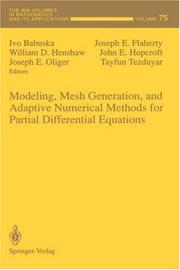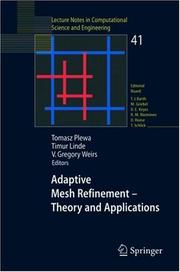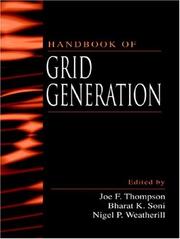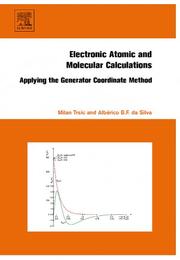| Listing 1 - 10 of 32 | << page >> |
Sort by
|
Book
ISBN: 1000023534 3866446993 Year: 2011 Publisher: KIT Scientific Publishing
Abstract | Keywords | Export | Availability | Bookmark
 Loading...
Loading...Choose an application
- Reference Manager
- EndNote
- RefWorks (Direct export to RefWorks)
Engineering materials show a pronounced heterogeneity on a smaller scale that influences the macroscopic constitutive behavior. Algorithms for the periodic discretization of microstructures are presented. These are used within the Nonuniform Transformation Field Analysis (NTFA) which is an order reduction based nonlinear homogenization method with micro-mechanical background. Theoretical and numerical aspects of the method are discussed and its computational efficiency is validated.
microstructure --- order reduction method --- mesh generation --- computational homogenization --- composite materials
Dissertation
Year: 2021 Publisher: Liège Université de Liège (ULiège)
Abstract | Keywords | Export | Availability | Bookmark
 Loading...
Loading...Choose an application
- Reference Manager
- EndNote
- RefWorks (Direct export to RefWorks)
Managing the outcome of bone fracture healing is one of the most challenging tasks that a veterinary orthopedic surgeon has to accomplish. On top of the difficulties involved with unusual patient morphology, tight budgets and often short times to plan out surgeries in traumatic cases, surgeons have to deal with the delicate trade-off between assuring fracture stability and leaving enough interfragmentary motion to promote optimal bone healing on a case by case basis. While handbooks provide general guidelines for surgeons to follow in some situations, decisions are still often based on their experience and expertise gained on previous cases. Subject-specific models display the potential to positively alter the outcome of surgical operations by providing surgeons with numerical twins to test treatments on. They have previously been shown to be able to reproduce mechanical responses of both intact and orthopedically repaired bones. A continuation of these works is conducted here. In this thesis, an exploratory study is conducted to assess the capability of a Continuum Damage Mechanics-based remodeling model to represent the healing characteristics found in bone fracture healing. Along the way, the full numerical pipeline from the initial CT image to the Finite Element simulation is didactically presented and improvements made to it are detailed. Results include improvements to the image-to-mesh pipeline to increase its modularity and robustness. Meshes generated using the improved pipeline show greatly enhanced quality characteristics. Results also show that the extension of the Continuum Damage Mechanics-based remodeling model is able to qualitatively describe the multi-staged nature of bone fracture healing from a mechanical point of view.

ISBN: 0387945423 9780387945422 1461287073 1461242487 Year: 1995 Publisher: New York (N.Y.) : Springer,
Abstract | Keywords | Export | Availability | Bookmark
 Loading...
Loading...Choose an application
- Reference Manager
- EndNote
- RefWorks (Direct export to RefWorks)
Differential equations, Partial --- Numerical grid generation (Numerical analysis) --- Coordinate generation, Numerical (Numerical analysis) --- Generation of numerical grids (Numerical analysis) --- Grid generation, Numerical (Numerical analysis) --- Mesh generation, Numerical (Numerical analysis) --- Numerical coordinate generation (Numerical analysis) --- Numerical mesh generation (Numerical analysis) --- Boundary value problems --- Nets (Mathematics) --- Numerical analysis --- Numerical solutions --- Congresses. --- Partial differential equations --- Numerical solutions&delete& --- Congresses

ISBN: 3540211470 9783540211471 9786610412259 1280412259 3540270396 Year: 2005 Volume: 41 Publisher: Berlin: New York: Springer,
Abstract | Keywords | Export | Availability | Bookmark
 Loading...
Loading...Choose an application
- Reference Manager
- EndNote
- RefWorks (Direct export to RefWorks)
Differential equations, Partial --- Numerical grid generation (Numerical analysis) --- Coordinate generation, Numerical (Numerical analysis) --- Generation of numerical grids (Numerical analysis) --- Grid generation, Numerical (Numerical analysis) --- Mesh generation, Numerical (Numerical analysis) --- Numerical coordinate generation (Numerical analysis) --- Numerical mesh generation (Numerical analysis) --- Boundary value problems --- Nets (Mathematics) --- Numerical analysis --- Numerical solutions --- Conferences - Meetings --- Numerical grid generation (Numerical analysis) - Congresses --- Differential equations, Partial - Numerical solutions - Congresses

ISBN: 0849326877 9781420050349 1420050346 9780367802462 0367802465 9780849326875 Year: 1999 Publisher: Boca Raton, FL : CRC Press,
Abstract | Keywords | Export | Availability | Bookmark
 Loading...
Loading...Choose an application
- Reference Manager
- EndNote
- RefWorks (Direct export to RefWorks)
519.6 --- 681.3*G1 --- Computational mathematics. Numerical analysis. Computer programming --- Numerical analysis --- Numerical grid generation (Numerical analysis) --- Numerical grid generation (Numerical analysis). --- 681.3*G1 Numerical analysis --- 519.6 Computational mathematics. Numerical analysis. Computer programming --- Grilles (analyse numérique) --- Coordinate generation, Numerical (Numerical analysis) --- Generation of numerical grids (Numerical analysis) --- Grid generation, Numerical (Numerical analysis) --- Mesh generation, Numerical (Numerical analysis) --- Numerical coordinate generation (Numerical analysis) --- Numerical mesh generation (Numerical analysis) --- Boundary value problems --- Differential equations, Partial --- Nets (Mathematics) --- Numerical solutions
Book
ISBN: 3319017357 3319017365 9783319017358 Year: 2014 Publisher: Cham: Springer,
Abstract | Keywords | Export | Availability | Bookmark
 Loading...
Loading...Choose an application
- Reference Manager
- EndNote
- RefWorks (Direct export to RefWorks)
This book presents the classical theory of curves in the plane and three-dimensional space, and the classical theory of surfaces in three-dimensional space. It pays particular attention to the historical development of the theory and the preliminary approaches that support contemporary geometrical notions. It includes a chapter that lists a very wide scope of plane curves and their properties. The book approaches the threshold of algebraic topology, providing an integrated presentation fully accessible to undergraduate-level students. At the end of the 17th century, Newton and Leibniz developed differential calculus, thus making available the very wide range of differentiable functions, not just those constructed from polynomials. During the 18th century, Euler applied these ideas to establish what is still today the classical theory of most general curves and surfaces, largely used in engineering. Enter this fascinating world through amazing theorems and a wide supply of surprising examples. Reach the doors of algebraic topology by discovering just how an integer (= the Euler-Poincaré characteristics) associated with a surface gives you a lot of interesting information on the shape of the surface. And penetrate the intriguing world of Riemannian geometry, the geometry that underlies the theory of relativity. The book is of interest to all those who teach classical differential geometry up to quite an advanced level. The chapter on Riemannian geometry is of great interest to those who have to “intuitively” introduce students to the highly technical nature of this branch of mathematics, in particular when preparing students for courses on relativity.
Geometry, Differential. --- Numerical grid generation (Numerical analysis) --- Coordinate generation, Numerical (Numerical analysis) --- Generation of numerical grids (Numerical analysis) --- Grid generation, Numerical (Numerical analysis) --- Mesh generation, Numerical (Numerical analysis) --- Numerical coordinate generation (Numerical analysis) --- Numerical mesh generation (Numerical analysis) --- Differential geometry --- Mathematics. --- Geometry. --- Differential geometry. --- History. --- Differential Geometry. --- History of Mathematical Sciences. --- Boundary value problems --- Differential equations, Partial --- Nets (Mathematics) --- Numerical analysis --- Numerical solutions --- Global differential geometry. --- Geometry, Differential --- Mathematics --- Euclid's Elements --- Annals --- Auxiliary sciences of history --- Math --- Science
Book
ISBN: 1633216829 9781633216822 1611220130 9781611220131 Year: 2014 Publisher: New York : Nova Publishers,
Abstract | Keywords | Export | Availability | Bookmark
 Loading...
Loading...Choose an application
- Reference Manager
- EndNote
- RefWorks (Direct export to RefWorks)
Complex electromagnetic problems using new hybridised computational techniques combining the frequency domain Method of Moments (MoM), Finite-Difference Time-Domain (FDTD) and a subgridded Finite-Difference Time-Domain (SGFDTD) method are studied and discussed in detail. The techniques are desirable to predict electromagnetic absorption in inhomogeneous, anisotropic and lossy dielectric materials irradiated by geometrically intricate sources. In Method of Moments modelling, the surface kernel solution is derived for 1-D, 2-D and 3-D. The electric surface patch integral formulation is solved by
Electromagnetism --- Finite differences. --- Time-domain analysis. --- Numerical grid generation (Numerical analysis) --- Coordinate generation, Numerical (Numerical analysis) --- Generation of numerical grids (Numerical analysis) --- Grid generation, Numerical (Numerical analysis) --- Mesh generation, Numerical (Numerical analysis) --- Numerical coordinate generation (Numerical analysis) --- Numerical mesh generation (Numerical analysis) --- Boundary value problems --- Differential equations, Partial --- Nets (Mathematics) --- Numerical analysis --- Analysis, Time-domain --- System analysis --- Differences, Finite --- Finite difference method --- Electromagnetics --- Magnetic induction --- Magnetism --- Metamaterials --- Mathematical models. --- Numerical solutions

ISBN: 9780444527813 0444527818 1281027413 9781281027412 9786611027414 0080547087 Year: 2007 Publisher: Amsterdam ; London : Elsevier,
Abstract | Keywords | Export | Availability | Bookmark
 Loading...
Loading...Choose an application
- Reference Manager
- EndNote
- RefWorks (Direct export to RefWorks)
The Generator Coordinate Method (GCM) is a mathematical tool for the understanding of stable atomic nuclei. Electronic, Atomic and Molecular Calculations is designed to assist scientists applying GCM in the analysis of the electronic structure of atoms and molecules. There have been numerous publications covering nuclear physics and electronic structure of atoms and molecules, but this book is unique in the sense that it specifically addresses the application of GCM for such purposes. Using this book, researchers will be able to understand and calculate the electronic structure in a novel mann
Atomic structure --- Nuclear physics. --- Molecular structure --- Numerical grid generation (Numerical analysis) --- Coordinate generation, Numerical (Numerical analysis) --- Generation of numerical grids (Numerical analysis) --- Grid generation, Numerical (Numerical analysis) --- Mesh generation, Numerical (Numerical analysis) --- Numerical coordinate generation (Numerical analysis) --- Numerical mesh generation (Numerical analysis) --- Boundary value problems --- Differential equations, Partial --- Nets (Mathematics) --- Numerical analysis --- Structure, Molecular --- Chemical structure --- Structural bioinformatics --- Atomic nuclei --- Atoms, Nuclei of --- Nucleus of the atom --- Physics --- Structure, Atomic --- Atomic theory --- Mathematical models. --- Numerical solutions
Book
ISBN: 3319023349 3319023357 Year: 2014 Publisher: Cham, Switzerland : Springer,
Abstract | Keywords | Export | Availability | Bookmark
 Loading...
Loading...Choose an application
- Reference Manager
- EndNote
- RefWorks (Direct export to RefWorks)
This volume contains the articles presented at the 22nd International Meshing Roundtable (IMR) organized, in part, by Sandia National Laboratories and was held on Oct 13-16, 2013 in Orlando, Florida, USA. The first IMR was held in 1992, and the conference series has been held annually since. Each year the IMR brings together researchers, developers, and application experts in a variety of disciplines, from all over the world, to present and discuss ideas on mesh generation and related topics. The technical papers in this volume present theoretical and novel ideas and algorithms with practical potential, as well as technical applications in science and engineering, geometric modeling, computer graphics and visualization.
Numerical grid generation (Numerical analysis) --- Differential equations, Partial --- Numerical solutions --- Coordinate generation, Numerical (Numerical analysis) --- Generation of numerical grids (Numerical analysis) --- Grid generation, Numerical (Numerical analysis) --- Mesh generation, Numerical (Numerical analysis) --- Numerical coordinate generation (Numerical analysis) --- Numerical mesh generation (Numerical analysis) --- Engineering. --- Computer science --- Computer simulation. --- Applied mathematics. --- Engineering mathematics. --- Appl.Mathematics/Computational Methods of Engineering. --- Math Applications in Computer Science. --- Simulation and Modeling. --- Mathematics. --- Boundary value problems --- Nets (Mathematics) --- Numerical analysis --- Computer science. --- Mathematical and Computational Engineering. --- Computer modeling --- Computer models --- Modeling, Computer --- Models, Computer --- Simulation, Computer --- Electromechanical analogies --- Mathematical models --- Simulation methods --- Model-integrated computing --- Informatics --- Science --- Engineering --- Engineering analysis --- Mathematical analysis --- Mathematics --- Computer science—Mathematics.
Book
ISBN: 9048129117 9400730780 1282834312 9786612834318 9048129133 9048129125 Year: 2010 Publisher: Dordrecht : Springer,
Abstract | Keywords | Export | Availability | Bookmark
 Loading...
Loading...Choose an application
- Reference Manager
- EndNote
- RefWorks (Direct export to RefWorks)
This book is an introduction to structured and unstructured grid methods in scientific computing, addressing graduate students, scientists as well as practitioners. Basic local and integral grid quality measures are formulated and new approaches to mesh generation are reviewed. In addition to the content of the successful first edition, a more detailed and practice oriented description of monitor metrics in Beltrami and diffusion equations is given for generating adaptive numerical grids. Also, new techniques developed by the author are presented, in particular a technique based on the inverted form of Beltrami’s partial differential equations with respect to control metrics. This technique allows the generation of adaptive grids for a wide variety of computational physics problems, including grid clustering to given function values and gradients, grid alignment with given vector fields, and combinations thereof. Applications of geometric methods to the analysis of numerical grid behavior as well as grid generation based on the minimization of functionals of smoothness, conformality, orthogonality, energy, and alignment complete the second edition of this outstanding compendium on grid generation methods.
Numerical grid generation (Numerical analysis). --- Numerical grid generation (Numerical analysis) --- Applied Physics --- Calculus --- Mathematics --- Engineering & Applied Sciences --- Physical Sciences & Mathematics --- Numerical analysis. --- Coordinate generation, Numerical (Numerical analysis) --- Generation of numerical grids (Numerical analysis) --- Grid generation, Numerical (Numerical analysis) --- Mesh generation, Numerical (Numerical analysis) --- Numerical coordinate generation (Numerical analysis) --- Numerical mesh generation (Numerical analysis) --- Physics. --- Computer science --- Computer mathematics. --- Applied mathematics. --- Engineering mathematics. --- Theoretical, Mathematical and Computational Physics. --- Computational Mathematics and Numerical Analysis. --- Mathematics of Computing. --- Appl.Mathematics/Computational Methods of Engineering. --- Mathematics. --- Boundary value problems --- Differential equations, Partial --- Nets (Mathematics) --- Numerical analysis --- Mathematical analysis --- Numerical solutions
| Listing 1 - 10 of 32 | << page >> |
Sort by
|

 Search
Search Feedback
Feedback About UniCat
About UniCat  Help
Help News
News